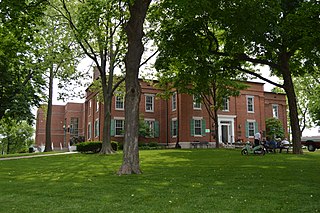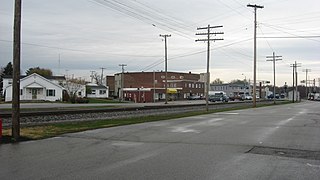| Homberg, Illinois | |
|---|---|
| Unincorporated community | |
| Coordinates: 37°19′31″N88°33′07″W / 37.32528°N 88.55194°W Coordinates: 37°19′31″N88°33′07″W / 37.32528°N 88.55194°W | |
| Country | United States |
| State | Illinois |
| County | Pope |
| Elevation | 367 ft (112 m) |
| Time zone | Central (CST) (UTC-6) |
| • Summer (DST) | CDT (UTC-5) |
| Area code(s) | 618 |
| GNIS feature ID | 425007 [1] |
Homberg is an unincorporated community in Pope County, Illinois, United States, near the Ohio River and about five miles (8 km) southwest of the county seat of Golconda. It is on a flat riverbed, a former channel of the Ohio River when the river turned west and flowed a bit south of the present Illinois Route 146, crossing the current Mississippi River south of Cape Girardeau, Missouri, eventually merging with the Mississippi of that time, near Memphis, Tennessee. Earthquakes of 10,000 years ago may have helped change the channels of the rivers.

Pope County is a county located in the U.S. state of Illinois. According to the 2010 census, it had a population of 4,470, making it the second-least populous county in Illinois. Its county seat is Golconda. The county was organized in 1816 from portions of Gallatin and Johnson counties and named after Nathaniel Pope, a politician and jurist from the Illinois Territory and State of Illinois.

Illinois is a state in the Midwestern and Great Lakes region of the United States. It has the fifth largest gross domestic product (GDP), the sixth largest population, and the 25th largest land area of all U.S. states. Illinois is often noted as a microcosm of the entire United States. With Chicago in northeastern Illinois, small industrial cities and immense agricultural productivity in the north and center of the state, and natural resources such as coal, timber, and petroleum in the south, Illinois has a diverse economic base, and is a major transportation hub. Chicagoland, Chicago's metropolitan area, encompasses over 65% of the state's population. The Port of Chicago connects the state to international ports via two main routes: from the Great Lakes, via the Saint Lawrence Seaway, to the Atlantic Ocean and from the Great Lakes to the Mississippi River, via the Illinois Waterway to the Illinois River. The Mississippi River, the Ohio River, and the Wabash River form parts of the boundaries of Illinois. For decades, Chicago's O'Hare International Airport has been ranked as one of the world's busiest airports. Illinois has long had a reputation as a bellwether both in social and cultural terms and, through the 1980s, in politics.

The United States of America (USA), commonly known as the United States or America, is a country composed of 50 states, a federal district, five major self-governing territories, and various possessions. At 3.8 million square miles, the United States is the world's third or fourth largest country by total area and is slightly smaller than the entire continent of Europe's 3.9 million square miles. With a population of over 327 million people, the U.S. is the third most populous country. The capital is Washington, D.C., and the largest city by population is New York City. Forty-eight states and the capital's federal district are contiguous in North America between Canada and Mexico. The State of Alaska is in the northwest corner of North America, bordered by Canada to the east and across the Bering Strait from Russia to the west. The State of Hawaii is an archipelago in the mid-Pacific Ocean. The U.S. territories are scattered about the Pacific Ocean and the Caribbean Sea, stretching across nine official time zones. The extremely diverse geography, climate, and wildlife of the United States make it one of the world's 17 megadiverse countries.
A rail line, used to transport feldspar mined near Rosiclare, ran through Homberg, which was abandoned as the mining died. Constructing the rail line brought its special problems. The rail line was officially removed in 1982{fact}. A small foodstore which doubled as a post office, continued until the 1970s. The bluff along the north side of the old river bed is 240 feet high.

Feldspars (KAlSi3O8 – NaAlSi3O8 – CaAl2Si2O8) are a group of rock-forming tectosilicate minerals that make up about 41% of the Earth's continental crust by weight.
Reevesville and Brownfield were two nearby rail stops. A story handed down by a Homberg family recounts that:
In 1902, people were dressed in their Sunday best clothes to welcome the first train on the track. The ladies were, of course, conditioned to think only of horse transportation. The train stopped so they could have a look at it. Then the train engineer announced "Ladies, please put your parasols down, because it makes the train afraid to pass." Legend says two or three ladies dutifully folded up their parasols, before they likely heard chuckles from the crowd.

The horse is one of two extant subspecies of Equus ferus. It is an odd-toed ungulate mammal belonging to the taxonomic family Equidae. The horse has evolved over the past 45 to 55 million years from a small multi-toed creature, Eohippus, into the large, single-toed animal of today. Humans began domesticating horses around 4000 BC, and their domestication is believed to have been widespread by 3000 BC. Horses in the subspecies caballus are domesticated, although some domesticated populations live in the wild as feral horses. These feral populations are not true wild horses, as this term is used to describe horses that have never been domesticated, such as the endangered Przewalski's horse, a separate subspecies, and the only remaining true wild horse. There is an extensive, specialized vocabulary used to describe equine-related concepts, covering everything from anatomy to life stages, size, colors, markings, breeds, locomotion, and behavior.





















